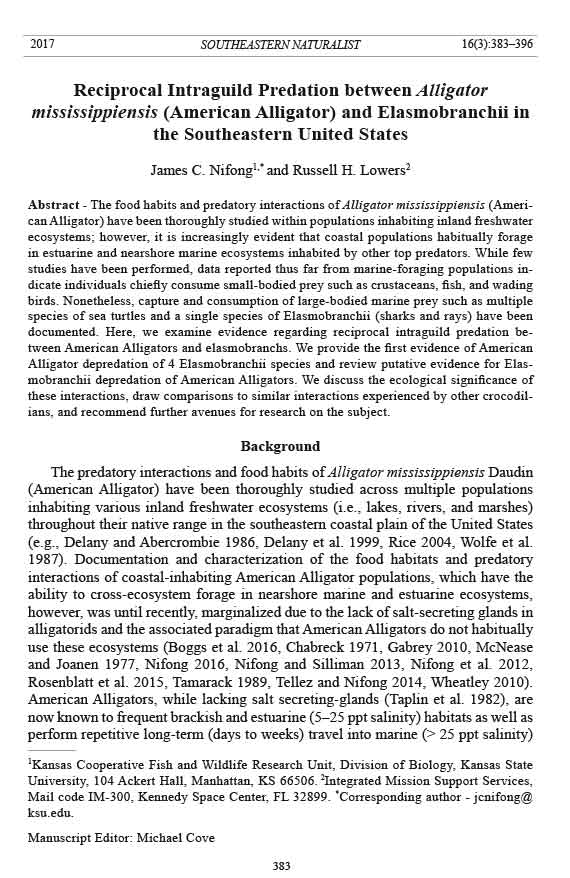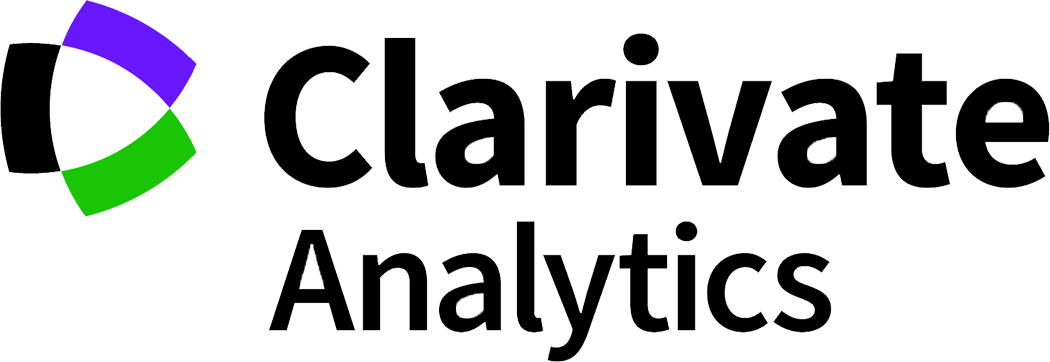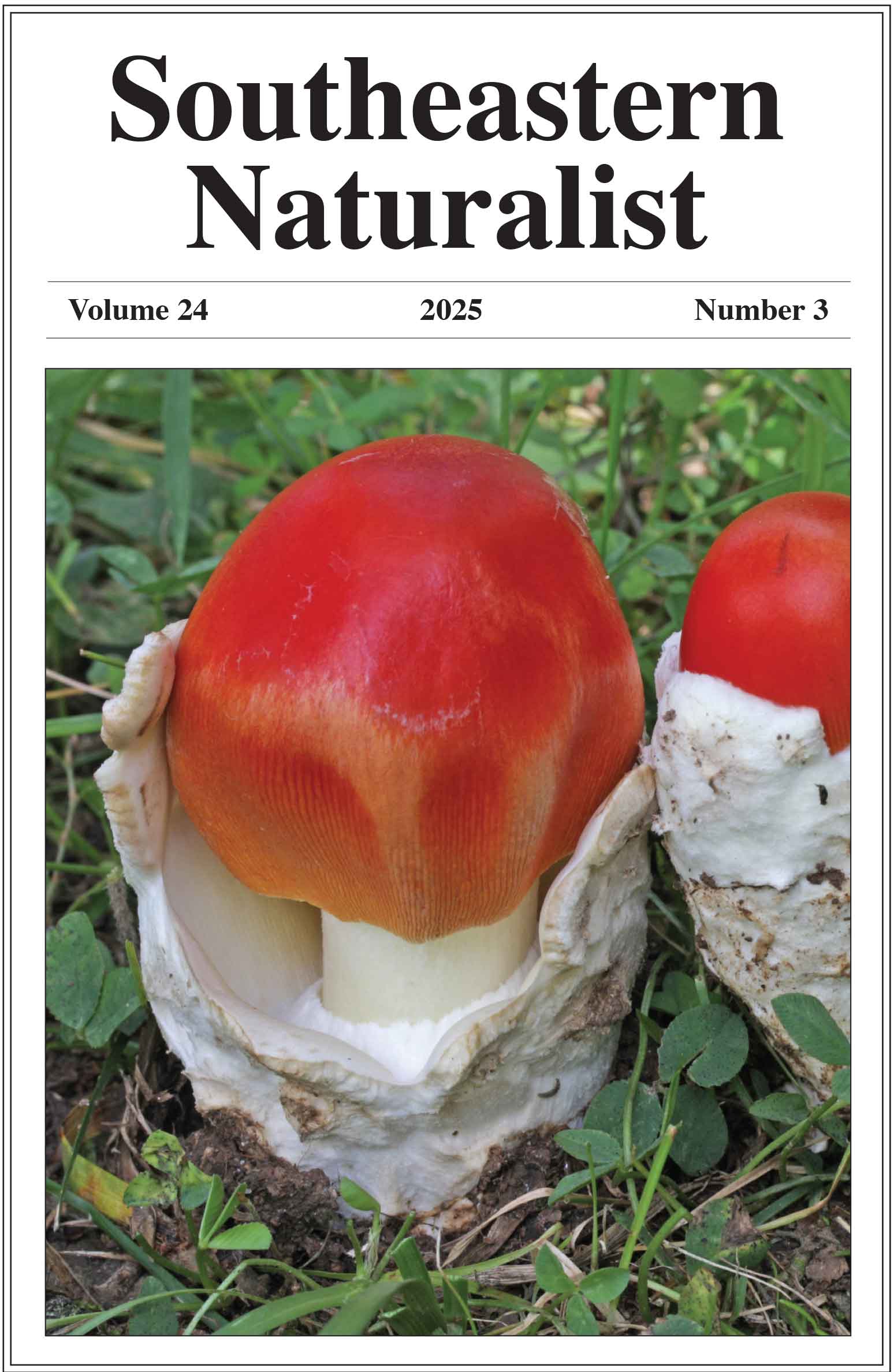Reciprocal Intraguild Predation between Alligator
mississippiensis (American Alligator) and Elasmobranchii in
the Southeastern United States
James C. Nifong and Russell H. Lowers
Southeastern Naturalist, Volume 16, Issue 3 (2017): 383–396
Full-text pdf (Accessible only to subscribers.To subscribe click here.)

Southeastern Naturalist
383
J.C. Nifong and R.H. Lowers
22001177 SOUTHEASTERN NATURALIST 1V6o(3l.) :1368,3 N–3o9. 63
Reciprocal Intraguild Predation between Alligator
mississippiensis (American Alligator) and Elasmobranchii in
the Southeastern United States
James C. Nifong1,* and Russell H. Lowers2
Abstract - The food habits and predatory interactions of Alligator mississippiensis (American
Alligator) have been thoroughly studied within populations inhabiting inland freshwater
ecosystems; however, it is increasingly evident that coastal populations habitually forage
in estuarine and nearshore marine ecosystems inhabited by other top predators. While few
studies have been performed, data reported thus far from marine-foraging populations indicate
individuals chiefly consume small-bodied prey such as crustaceans, fish, and wading
birds. Nonetheless, capture and consumption of large-bodied marine prey such as multiple
species of sea turtles and a single species of Elasmobranchii (sharks and rays) have been
documented. Here, we examine evidence regarding reciprocal intraguild predation between
American Alligators and elasmobranchs. We provide the first evidence of American
Alligator depredation of 4 Elasmobranchii species and review putative evidence for Elasmobranchii
depredation of American Alligators. We discuss the ecological significance of
these interactions, draw comparisons to similar interactions experienced by other crocodilians,
and recommend further avenues for research on the subject.
Background
The predatory interactions and food habits of Alligator mississippiensis Daudin
(American Alligator) have been thoroughly studied across multiple populations
inhabiting various inland freshwater ecosystems (i.e., lakes, rivers, and marshes)
throughout their native range in the southeastern coastal plain of the United States
(e.g., Delany and Abercrombie 1986, Delany et al. 1999, Rice 2004, Wolfe et al.
1987). Documentation and characterization of the food habitats and predatory
interactions of coastal-inhabiting American Alligator populations, which have the
ability to cross-ecosystem forage in nearshore marine and estuarine ecosystems,
however, was until recently, marginalized due to the lack of salt-secreting glands in
alligatorids and the associated paradigm that American Alligators do not habitually
use these ecosystems (Boggs et al. 2016, Chabreck 1971, Gabrey 2010, McNease
and Joanen 1977, Nifong 2016, Nifong and Silliman 2013, Nifong et al. 2012,
Rosenblatt et al. 2015, Tamarack 1989, Tellez and Nifong 2014, Wheatley 2010).
American Alligators, while lacking salt secreting-glands (Taplin et al. 1982), are
now known to frequent brackish and estuarine (5–25 ppt salinity) habitats as well as
perform repetitive long-term (days to weeks) travel into marine (> 25 ppt salinity)
1Kansas Cooperative Fish and Wildlife Research Unit, Division of Biology, Kansas State
University, 104 Ackert Hall, Manhattan, KS 66506. 2Integrated Mission Support Services,
Mail code IM-300, Kennedy Space Center, FL 32899. *Corresponding author - jcnifong@
ksu.edu.
Manuscript Editor: Michael Cove
Southeastern Naturalist
J.C. Nifong and R.H. Lowers
2017 Vol. 16, No. 3
384
habitats (Elsey 2005, Mazzotti and Dunson 1989, Nifong and Silliman 2017, Nifong
et al. 2015, Rosenblatt and Heithaus 2011, Tamarack 1989).
The reported findings from stomach-content studies and observations made
within estuarine and marine ecosystems indicate that American Alligators primarily
feed on crustaceans (i.e., crabs and shrimp), Limulus polyphemus (L.) (Atlantic
Horseshoe Crab), small fish and minnows (i.e., Fundulidae [mud minnows], Cyprinidae
[top minnows], Mugil cephalus L. [Striped Mullet], etc.), small mammals
(i.e., rodents, Neovison vison Schreber, [American Mink], Procyon lotor L. [Raccoon],
etc.), and wading birds (Chabreck 1971; Gabrey 2010; Nifong 2016; Nifong
et al. 2012, 2015; Rosenblatt et al. 2015; Tamarack 1989; Valentine et al. 1972).
In addition, albeit reported less frequently, coastal-inhabiting American Alligators
are documented to consume larger-bodied marine prey. For example, Nifong et al.
(2011) reported 6 accounts of scavenging and putative predation on 2 sea turtle species,
Caretta caretta L. (Loggerhead Sea Turtle) and Chelonia mydas L. (Green Sea
Turtle), by American Alligators along the southeastern US Atlantic coast. In terms
of the depredation of Elasmobranchii, the only published evidence was reported
by Tamarack (1993), who provided putative evidence (embedded spines in the jaw
and head) of Dasyatis americana Hildebrand and Schroeder (Southern Stingray)
depredation by a 314-cm total length (TL) male and a 158-cm TL female Alligator
captured near St. Catherines Island, GA (31.624372°N, 81.152887°W; Fig. 1).
Here we present the first records of American Alligators consuming 4 species
of Elasmobranchii, Ginglymostoma cirratum (Bonnaterre) (Nurse Shark), Sphyrna
tiburo (L.) (Bonnethead Shark), Negaprion brevirostris (Poey) (Lemon Shark),
and Dasyatis sabina (Lesueur) (Atlantic Stingray). We then review observations
and putative evidence for depredation of American Alligators by Elasmobranchii.
We discuss the ecological significance of these interactions, draw comparisons to
the documented interactions of other crocodilian species, and recommend further
avenues for research on the subject.
Depredation of Elasmobranchii by American Alligators
On Wassaw Island, GA (31.880737°N, 80.968109°W; Fig. 1), a marine turtle
researcher (M. Frick, University of Florida, Gainesville, FL, unpubl. data) observed
several instances of elasmobranch depredation by American Alligators.
Specifically, on 21 June 1997 during sea turtle nesting surveys along the oceanfront
beaches (>25 ppt) of Wassaw Island, an adult American Alligator (~250 cm TL,
sex unknown) was observed attacking and consuming a Bonnethead Shark. Later,
on 7 July 1999, the same researcher observed a sub-adult (~160 cm TL) American
Alligator capture and consume a juvenile Lemon Shark in the surf zone. No photographs
were obtained.
On 2 August 2003, a United States Fish and Wildlife Service (USFWS) staff
member observed and photographed an American Alligator (~250 cm TL) capturing,
manipulating, and consuming a Nurse Shark (~100 cm TL) (Fig. 2) in an
estuarine (10–35 ppt) mangrove swamp (26.471047°N, 82.151627°W; Fig. 1)
within the Ding Darling National Wildlife Refuge in Sanibel, FL.
Southeastern Naturalist
385
J.C. Nifong and R.H. Lowers
2017 Vol. 16, No. 3
On 19 September 2006 at 1528, a naturalist (J. Cooke, St. Marks, FL) while
viewing foraging wading birds, observed and photographed an adult American Alligator,
presumably male based on body size (~300 cm TL), capture, manipulate,
and consume an adult Bonnethead Shark (Fig. 3) in a tidal salt marsh (15–35 ppt)
Figure 1. Map of the southeastern United States. Circles containing a crocodile symbol are
localities where American Alligators acted as predators of Elasmobranchii (n = 7 records)
and circles containing a fish symbol are locations of historical accounts describing Elasmobranchii
depredation of American Alligators (n = 3 records).
Figure 2: Photographs of an adult American Alligator capturing (left) and manipulating
(right) a Nurse Shark prior to consumption in a estuarine mangrove swamp within the Ding
Darling National Wildlife Refuge in Sanibel, FL. Photographs courtesy of USFWS.
Southeastern Naturalist
J.C. Nifong and R.H. Lowers
2017 Vol. 16, No. 3
386
of St. Marks, FL (30.156747°N, 84.219081°W; Fig. 1). The observer documented
the event through a series of 12 photographs.
The final set of accounts were recorded in estuarine habitats (15–25 ppt)
surrounding Cape Canaveral, FL (28.512411°N, 80.607415°W; Fig. 1) from 3
October 2008 to 13 January 2011. First, on 3 October 2008 during routine captures
performed for ecological research, an adult female American Alligator
(236 cm TL) was captured while holding a juvenile Atlantic Stingray in her jaws
(28.57385°N, 80.58896°W; Fig. 4). During capture, the female released the stingray
and researchers were unable to recover the remains. Subsequent captures in
this general location yielded 2 other American Alligators, a female (240 cm TL,
captured on 10 November 2010 at 28.61438°N, 80.66576°W; Fig. 1) and a male
(295 cm TL, captured on 13 January 2011 at 28.59127°N, 80.68087°W), with
stingray barbs (unidentified species, likely from Atlantic Stingrays) embedded in
their jaw and neck (Fig. 5), presumably received while attacking and manipulating
stingrays prior to their consumption.
Depredation of American Alligators by Elasmobranchii
The only reports of Elasmobranchii depredation of American Alligators originate
from a series of eye-witness accounts published in newspapers and magazines
in the late 1800s. First, on 5 October 1877 the sports magazine The Fishing Gazette
Figure 3. Photographs of an ~3 m TL male American Alligator capturing (top-left), manipulating
(top-right and bottom-left), and consuming (bottom-right) an adult Bonnethead Shark
in salt marsh near St. Marks, FL. Photographs © Judy Cooke.
Southeastern Naturalist
387
J.C. Nifong and R.H. Lowers
2017 Vol. 16, No. 3
published an article entitled “Alligator and Shark Fight”, recounting the observations
of an epic skirmish between American Alligators and sharks (unknown
species) in a tidal inlet near Jupiter, Florida (26.946583° N, 80.080181°W; Fig. 1).
Figure 4. Photographs of an adult American Alligator captured while biting an Atlantic
Stingray in the upper Banana River Estuary of Cape Canaveral, FL. Photographs © R.H.
Lowers.
Figure 5. Photographs of an adult American Alligator captured (top-left) with stingray barb
lodged in the dorsal region of the neck (top-left and top-right, white arrow indicates location
of the barb). Researchers removed the barb (bottom-left), measuring ~9 cm (bottom-right).
Photographs © R.H. Lowers.
Southeastern Naturalist
J.C. Nifong and R.H. Lowers
2017 Vol. 16, No. 3
388
The observers claim a large number of American Alligators (~500 individuals)
congregated within a bight in the inlet to take advantage of schools of fish trapped
there by a strong flood tide (Alligators and ... 1877). A few days following this
feeding aggregation, the combination of a strong northwest wind and high tide
caused the water and the engorged American Alligators trapped in the bight to flow
out into the main channel of the inlet. It was said that in the inlet a mass school
of sharks (hundreds) had congregated, likely drawn by the smell of blood and the
feeding activities of the Alligators. Once in the inlet, the Alligators were attacked
by the awaiting sharks. Quoting from an eye-witness statement “…[the] sharks and
alligators rise on the crest of the waves and fight like dogs”. In the days following
the skirmish, carried by strong currents, numerous carcasses of both American Alligators
and sharks were reported to have washed ashore along beaches extending
to Cape Malabar, FL (nearly 130 km to the north).
Second, on 14 May 1884 the periodical The Palatka Daily News published
an account (unknown author) describing a mortal contest between a shark (300
cm TL, species not reported) and a American Alligator (210 cm TL) at East Pass
near Pilot Cove, FL (30.395858°N, 86.519194°W; Fig. 1). Described therein, following
multiple attempts by the shark, a mortal bite was delivered to the thoracic
region of the American Alligator, severing the individual in 2 portions. Then the
shark was then observed consuming one half of the American Alligator remains
(A shark ... 1884).
The next account was published in 1888 (unknown publisher and unknown
author) in an article entitled “Sharks and Alligators: Furious duel on the coast of
Florida”, which describes a lengthy, larger-than-life clash between 5 or 6 American
Alligators (the largest reported to be 465 cm TL, was likely an exaggeration) and
a comparable number of sharks (body size and species not reported), witnessed by
a group of fisherman in the tidal Indian River, FL (28.567348°N, 80.762268°W;
Fig. 1). Observers noted that during the altercation the sharks removed the forelimbs
as well as portions of the tail from several of the alligators involved in the
skirmish and that several of the sharks as well as alligators suffered mortal injuries.
Furthermore, the author(s) of this article report interactions such as this were commonly
observed during this period (Sharks and ... 1888).
Discussion
Crocodilians and elasmobranchs have shared foraging grounds since the appearance
of Crocodylia in the Mesozoic era (~80 Ma), and evidence from the
fossil record suggest these top predators have historically engaged in predatory
exchanges with one another (Hill et al. 2015). Here, we discuss contemporary evidence
regarding reciprocal intraguild predation between American Alligators and
elasmobranchs in the southeastern United States. Recent observations expand the
number of elasmobranch species depredated by American Alligators (increase from
1 to 5 species) as well as significantly extends the geographic range over which
these interactions are known to occur.
Southeastern Naturalist
389
J.C. Nifong and R.H. Lowers
2017 Vol. 16, No. 3
Depredation of Elasmobranchii by American Alligators
American Alligators are the most abundant large-bodied top predator in the
southeastern United States and inhabit a wide range of aquatic habitats from
freshwater lakes and rivers to estuaries and nearshore marine habitats (Conant
and Collins 1998, Nifong et al. 2015). The food habits and predatory interactions
of American Alligators, while thoroughly studied in freshwater systems, have received
comparatively little attention in estuarine and marine systems (e.g., Nifong
2016, Rosenblatt et al. 2015, Wheatley 2010). Observations reported here expand
the occurrence of Elasmobranchii in the American Alligator diet by 4 species and
dramatically extend the geographic range (Fig. 1) over which these interactions
have been observed (i.e., one barrier island in Georgia to multiple locations along
Florida’s coast into the Gulf of Mexico). Although these observations are limited,
depredation of Elasmobranchii is likely ubiquitous across the range of coastalinhabiting
American Alligators. These predation events potentially represent a
significant source of mortality for juvenile and small-bodied elasmobranchs that
occur in estuaries and nearshore marine habitats frequented by American Alligators,
as these areas are known to serve as nursery grounds for multiple Elasmobranchii
species (Curtis et al. 2011, Knip et al. 2010, Reyier et al. 2008). Furthermore,
findings from a semiochemical bioassay study indicate juveniles of at least one
Elasmobranchii species, the Lemon Shark, and likely others are not chemically
aware of American Alligators, whereas chemical exudates produced by Crocodylus
acutus Cuvier (American Crocodile) elicited responses (i.e., tonic immobility reversal)
in 53–80% of the trials depending on the concentration of exudates applied
(Rasmussen and Schmidt 1992). Thus, unsuspecting elasmobranchs may be more
susceptible to depredation by marine-foraging American Alligators as compared to
species of true crocodiles (Crocodylidae).
Certain elasmobranchs are euryhaline, and thus are not restricted to estuarine
and nearshore marine habitats. They have the ability to travel into freshwater
systems for considerable distances and extended periods of time. For example,
the euryhaline Atlantic Stingray (a documented prey species of American Alligators)
is well known to occur in freshwater rivers throughout its’ range and
has been documented to maintain permanent freshwater populations in the St.
Johns River, FL (Johnson and Snelson 1996, Piermarini and Evans 1998). Similarly,
Carcharhinus leucas (Müller and Henle) (Bull Shark) are well known to
travel considerable distances upstream in freshwater rivers, some establishing
landlocked populations (Montoya and Thorson 1982, Thorson et al. 1973). In
estuaries of the Florida Everglades, the distribution of immature Bull Sharks
overlaps with marine-foraging American Alligators (Rosenblatt and Heithaus
2011, Simpfendorfer et al. 2005). While no evidence exists, given the overlap in
habitats used, large American Alligators foraging in these estuaries potentially
consume immature Bull Sharks to some extent.
The absence of direct evidence for Elasmobranchii consumption from stomach-
content studies performed on coastal American Alligator populations is
likely driven by several factors. First, the majority of alligators subject to stomachSoutheastern
Naturalist
J.C. Nifong and R.H. Lowers
2017 Vol. 16, No. 3
390
content examination from coastal populations have been less than 250 cm TL, and
based on the reports of American Alligator predation on Elasmobranchii, it seems
that generally larger adult individuals (i.e., >250 cm TL) more frequently capture
and consume Elasmobranchii. Second, given the highly acidic gastric environment
maintained by alligators (pH ≤ 2; Coulson and Hernandez 1964), digestion of
Elasmobranchii tissues (excluding teeth and placoid scales) in the stomach is likely
to be very fast (1–3 days), and therefore researchers have a very short window of
opportunity to recover evidence, especially if only muscle and organ tissues are
consumed. Moreover, the small size of Elasmobranchii placoid scales may prevent
their collection in a sample depending on the size mesh used and also their detection
even when present, unless viewed under high magnification (≥ 25X). Future
stomach-content studies performed on coastal American Alligator populations
should attempt to include larger (TL > 250 cm) individuals and use small (≤1 mm)
mesh sieves to collect stomach effluent. In addition, contents should be carefully
inspected under high magnification to aid in the detection of pl acoid scales.
More broadly, considering the 24 recognized species of crocodilians that inhabit
tropical ecosystems worldwide, 5 other species attain large body sizes and
frequent estuarine and nearshore marine habitats where there is increased potential
to interact with Elasmobranchii taxa. Specifically, the species Crocodylus acutus
Cuvier (American Crocodile), C. moreletii Duméril and Bibron (Morelet’s Crocodile),
C. porosus Schneider (Estuarine Crocodile), C. palustris Lesson (Mugger
Crocodile), and C. niloticus Laurenti (Nile Crocodile) are potential predators of
Elasmobranchii.
Both historic and contemporary records exist documenting depredation of multiple
Elasmobranchii taxa by the aforementioned crocodile species. Perhaps the
most commonly reported are interactions between large (>300 cm TL) Estuarine
Crocodiles and various Elasmobranchii taxa along the coasts of Australia. Webb
and Manolis (1988) commented that large Estuarine Crocodiles in Northern Australia
occasionally eat small sharks, but this claim was not substantiated with data or
photographs. More recently, several online articles have been published describing
and in some cases providing photographs of Estuarine Crocodiles capturing and
consuming Bull Sharks (Hainke 2010, Keartes 2014). Magnusson (2015) reported
the use of dead sharks (multiple taxa) as bait to lure Estuarine Crocodiles into traps.
More recently, Morgan et al. (2017) examined scarring rates on juvenile Pristis
pristis (L.) (Freshwater Sawfish) along the tidal Fitzroy River in Western Australia.
They found nearly 60% of individuals studied had scarring from bite wounds, the
majority determined to be from failed predation attempts by Crocodylus johnstoni
Krefft (Freshwater Crocodile) and to a lesser extent Bull Sharks. Morgan et al.
(2017) postulate that while most predatory attempts by Freshwater Crocodiles
are likely unsuccessful, due to their small body size, attacks by the larger-bodied
Estuarine Crocodile would probably prove fatal for juvenile Freshwater Sawfish
migrating upstream from estuarine birthing grounds located in the lower portions
of the river. In Florida, known nursery grounds of the critically endangered
Pristis pectinata Latham (Smalltooth Sawfish) are frequented by large American
Southeastern Naturalist
391
J.C. Nifong and R.H. Lowers
2017 Vol. 16, No. 3
Alligators, especially during the wet season (P. O’Donnel, Florida Department
of Environmental Protection, Naples, FL, unpubl. data); given the propensity of
predatory attacks by crocodiles on Freshwater Sawfish in Australia, further examination
of the interactions between American Alligators and Smalltooth Sawfish is
warranted because studies may identify an overlooked source of mortality for the
juvenile life-stages of this critically endangered species.
The Nile Crocodile has also been documented to consume sharks. Cott (1961)
reported the stomach contents of single individual (unknown sex and body size)
out of 32 individuals sampled from KwaZulu-Natal, South Africa (likely coastal
locations), contained the remains of 2 unidentified shark species. While no records
exist, it is reasonable to assume that both Mugger Crocodiles and the American
Crocodiles consume Elasmobranchii to some degree. Mugger Crocodiles inhabit
large rivers also frequented by Bull Sharks. American as well as Morelet’s Crocodiles
inhabit estuarine and near-shore marine habitats known to serve as nursey
grounds for multiple shark species in addition to stingray and skate species. Future
stomach-content studies using the methods described for American Alligators will
likely provide documentation of such interactions for these species.
Depredation of American Alligators by Elasmobranchii
Evidence for the depredation of American Alligators by Elasmobranchii was
scant, only reported through eye-witness accounts published in a few newspaper
and magazine articles of the late 1800s (which were most certainly embellished to
some degree). During this period in time, it was reported these interactions were
common, but it seems most were the result of random happenstances rather than
directed prey pursuits by elasmobranchs. In the late 1800s, American Alligator
populations were far greater in size than in recent history, and individuals likely
traveled to estuarine and near-shore marine habitats more frequently and in greater
numbers than they do today (Allen and Neill 1949). Two of the reported events
were the product of feeding aggregations coinciding with extreme environmental
conditions. Feeding aggregations are common behavior among crocodilians as well
as sharks (Dinets 2015, Heupel and Simpfendorfer 2005), and these aggregations
often coincide with prey migrations and various environmental extremes (i.e.,
drought, spring tides, floods, etc.). Thus, the reported observations, while likely
embellished for theatrical effect, are plausible given the natural history and behavior
of the species involved.
Depredation and serious injury of other crocodilian species by Elasmobranchii
are more frequently reported. Price (1877) described an altercation between what
were likely Caiman crocodilus (L.) (Spectacled Caiman) and several sharks (unidentified
species) in Manzanilla, Mexico. Like the events described in several
accounts of American Alligator depredation, heavy rains had displaced a number
of Spectacled Caiman from a coastal freshwater lake into a tidal river. Once in the
river, the caiman were reportedly immediately attacked by sharks. Similar to accounts
for alligators, a violent battle was said to last all day, though, in this case
all Spectacled Caiman involved in the skirmish suffered mortality. In the July 1962
Southeastern Naturalist
J.C. Nifong and R.H. Lowers
2017 Vol. 16, No. 3
392
issue of the periodical Louisiana Conservationist published by the Louisiana Wildlife
and Fisheries Commission, the author of the article “What You Should Know
about Sharks” describes several findings of crocodilian remains in the stomachs of
large Galeocerdo cuvier (Péron and Lesueur) (Tiger Shark) captured in coastal waters
of Indonesia and South Africa. Described therein, a Tiger Shark (~3 m TL) was
captured somewhere off the coast of Indonesia with an entire Estuarine Crocodile
(2 m TL) in its stomach. Similarly, off the coast of Durban, South Africa, a Tiger
Shark (~4 m TL) contained the head and upper body portions of a Nile Crocodile
along with the hind limbs of a Ovis aries L. (Domestic Sheep), 3 seagulls (undefined
taxa), 2 cans of peas, and a cigarette tin. More recently, Somaweera et al.
(2013) reported that hatchling and juvenile Estuarine Crocodiles as well as Freshwater
Crocodiles inhabting tidal rivers in northern Australia are consumed by Tiger
Sharks, Carcharhinus amboinensis (Müller and Henle) (Pigeye Shark), and Glyphis
spp. (river sharks) as well as a large predatory fish, Lates calcarifer (Bloch) (Barramundi).
Webb and Messel (1977) attributed numerous tail amputations observed
in hatchling Estuarine Crocodiles to shark attacks. In addition, several web pages
have published putative evidence for the predation of crocodiles by sharks. Nelson
(2013) reported photographs and video detailing the discovery of the head of a
Nile Crocodile (~3.5 m TL) on a beach in St. Lucia, South Africa. In light of the
clean bite wound, apparent teeth marks, and the fact that poachers would have most
certainly retained the skull as a trophy, it was postulated that only Carcharodon
carcharias (L.) (Great White Shark) could have delivered such a mortal bite. In
Columbia, Great White Sharks have been documented to prey upon adult American
Crocodiles (Medem 1981), which attain similar body sizes to Nile Crocodiles.
Both the Tiger Shark and Bull Shark (known crocodile predators) occur in
coastal habitats frequented by American Alligators; these elasmobranchs can kill
and consume crocodilians similar in body size to American Alligators. We suggest,
stomach-content analysis of large-bodied individuals occurring sympatrically with
American Alligators may help to assess the importance and prevalence of these
interactions in the southeastern United States.
Conclusion
Crocodilians and elasmobranchs have shared foraging grounds for millions
of years. While infrequent, predatory interactions between these taxa do occur.
Here, we present novel observations of American Alligator depredation and putative
predation of 4 elasmobranch species (i.e., Bonnet Head Shark, Lemon Shark,
Nurse Shark, and Atlantic Stingray), increasing the number of known elasmobranch
prey from 1 (i.e., Southern Stingray) to 5 species and significantly extending the
geographical range over which these interactions are known to occur. The lack of
evidence for these interactions is likely a product of the extreme gastric environment
possessed by crocodilians and the failure of researchers to capture individuals
within the narrow window of time post-consumption that consumed elasmobranch
body portions are identifiable. Application of the techniques described herein
should assist researchers in gathering additional evidence to understand the extent
of these interactions. The near-shore marine and estuarine ecosystems where these
Southeastern Naturalist
393
J.C. Nifong and R.H. Lowers
2017 Vol. 16, No. 3
interactions occur serve as nursey grounds for a variety of elasmobranchs including
threatened and endangered species. Consumption of juveniles by American
Alligators and other crocodilians worldwide likely represents an important and
previously overlooked source of mortality for young and small-bodied elasmobranchs
(Morgan et al. 2017). Quantification and incorporation of these interactions
into predictive models will likely improve population-modeling efforts for certain
elasmobranch taxa, especially threatened species that spatially overlap with crocodilians.
Reciprocal depredation of American Alligators and other crocodilians by
elasmobranchs appears to be of minor significance. However, multiple observations
document these interactions globally, and knowledge of these interactions should
be incorporated into our understanding of crocodilian natural history and ecology
(Somaweera et al. 2013).
Acknowledgments
We would like to thank all individuals who provided observations and photographs, as
well as Kent Vliet for copies of relevant articles and accounts.
Literature Cited
A shark attacks an alligator. 1884. The Palatka Daily News, May 14. P. 1. Palatka, FL.
Allen, E.R., and W.T. Neill. 1949. Increasing abundance of the alligator in the eastern portion
of its range. Herpetologica 5:109–112.
Alligator and sharks fight. 1877. The Fishing Gazette, October. P. 7.
Boggs, A.S.P., H.J. Hamlin, J.C. Nifong, B.L. Kassim, R.H. Lowers, T.M. Galligan, S.E.
Long, and L.J. Guillette Jr. 2016. Urinary iodine and stable isotope analysis to examine
habitat influences on thyroid hormones among coastal dwelling American Alligators.
General and Comparative Endocrinology 226:5–13.
Chabreck, R.H. 1971. The foods and feeding habits of alligators from fresh and saline environments
in Louisiana. Proceedings of the Southeastern Association of Game and Fish
Commissioners 25:117–124.
Conant, R., and J.T. Collins. 1998. A Guide to Reptiles and Amphibians of Eastern and Central
North America. Third Edition. Houghton Mifflin Company, New York, NY. 616 pp.
Cott, H.B. 1961. Scientific results of an enquiry into the ecology and economic status of the
Nile Crocodile (Crocodylus noloticus) in Uganda and Northern Rhodesia. Transactions
of the Zoological Society of London 29:211–356.
Coulson, R.A., and T. Hernandez. 1964. Biochemistry of the Alligator: A Study of Metabolism
in Slow Motion. Louisiana State University Press, Baton Rouge, LA. 138 pp.
Curtis, T.H., D.H. Adams, and G.H. Burgess. 2011. Seasonal distribution and habitat associations
of Bull Sharks in the Indian River Lagoon, Florida: A 30-Year synthesis.
Transactions of the American Fisheries Society 140:1213–1226.
Delany, M.F., and C. Abercrombie. 1986. American Alligator food habits in northcentral
Florida. The Journal of Wildlife Management 50:348–353.
Delany, M.F., S.B. Linda, and C.T. Moore. 1999. Diet and condition of American Alligators
in 4 Florida lakes. Proceedings of the Annual Conference of the Southeastern Association
of Fish and Wildlife Agencies 53:375–389.
Dinets, V. 2015. Apparent coordination and collaboration in cooperatively hunting crocodilians.
Ethology Ecology and Evolution 27:244–250.
Southeastern Naturalist
J.C. Nifong and R.H. Lowers
2017 Vol. 16, No. 3
394
Elsey, R.M. 2005. Unusual offshore occurrence of an American Alligator. Southeastern
Naturalist 4:533–536.
Gabrey, S.W. 2010. Demographic and geographic variation in food habits of American
Alligators (Alligator mississippiensis) in Louisiana. Herpetological Conservation and
Biology 5:241–250.
Hainke, N. 2010. Monster crocodile gobbles up a shark in Kakadu National Park. Available
online at http://www.dailytelegraph.com.au/monster-crocodile-gobbles-up-a-shark-inkakadu-
national-park/news-story/c138f436b84fe69eb364421d48c8257b. Accessed 23
December 2016.
Heupel, M.R., and C.A. Simpfendorfer. 2005. Quantitative analysis of aggregation behavior
in juvenile Blacktip Sharks. Marine Biology 147:1239–1249.
Hill, R.V., E.M. Roberts, L. Tapanila, M.L. Bouare, F. Sissoko, and M.A. O’leary. 2015.
Multispecies shark feeding in the Trans-Saharan Seaway: Evidence from late Cretaceous
Dyrosaurid (Crocodyliformes) fossils from northeastern Mali. Palaios 30:589–596.
Johnson, M.R., and F.F. Snelson, Jr. 1996. Reproductive life history of the Atlantic Stingray,
Dasyatis sabina (Pisces, Dasyatidae), in the freshwater St. Johns River, Florida. Bulletin
of Marine Science 59:74–88.
Keartes, S. 2014. Three-legged crocodile nabs shark in Australia river. Available online at
http://www.earthtouchnews.com/natural-world/predator-vs-prey/three-legged-crocodile-
nabs-shark-in-australia-river. Accessed 23 December 2016.
Knip, D.M., M.R. Heupel, and C.A. Simpfendorfer. 2010. Sharks in nearshore environments:
Models, importance, and consequences. Marine Ecology Progress Series
402:1–11.
Magnusson, W. E. 2015. Eye of the Crocodile. Open Science, New York, NY. 459 pp.
Mazzotti, F.J., and W.A. Dunson. 1989. Osmoregulation in crocodilians. American Zoologist
29:903–920.
McNease, L., and T. Joanen. 1977. Alligator diets in relation to marsh salinity. Proceedings
of the Annual Conference of the Southeastern Association of Fish and Wildlife Agencies
31:36–40.
Medem, F. 1981. Los Crocodylia de Sur America, Volume 1: Los Crocodylia de Colombia.
Colciencias, Bogotá, Colombia. 354 pp.
Montoya, R.V., and T.B. Thorson. 1982. The Bull Shark (Carcharhinus leucas) and Largetooth
Sash (Pristis perotteti) in Lake Bayano, a tropical man-made impoundment in
Panama. Environmental Biology of Fishes 7:341–347.
Morgan, D.L., R. Somaweera, A.C. Gleiss, S.J. Beatty, and J.M. Whitty. 2017. An upstream
migration fought with danger: Freshwater sawfish fending off sharks and crocodiles.
Ecology 98:1465–1467.
Nelson, S.C. 2013. Was giant crocodile killed by huge shark? Head washes up on South
African beach. Available online at http://www.huffingtonpost.co.uk/2013/01/13/
giant-crocodile--shark-head-south-african-beach_n_2467794.html. Accessed 23 December
2016.
Nifong, J.C. 2016. Living on the edge: Trophic ecology of Alligator mississippiensis
(American alligator) with access to a shallow estuarine impoundment. Bulletin of the
Florida Museum of Natural History 54:13–49.
Nifong, J.C., and B. Silliman. 2013. Impacts of a large-bodied, apex predator (Alligator
mississippiensis Daudin 1801) on salt marsh food webs. Journal of Experimental Marine
Biology and Ecology 440:185–191.
Southeastern Naturalist
395
J.C. Nifong and R.H. Lowers
2017 Vol. 16, No. 3
Nifong, J.C., and B. Silliman. 2017. Abiotic factors influence the dynamics of marine habitat
use by a highly mobile “freshwater” top predator. Hydrobiologia. Available online at
doi:1007/s10750-017-3255-7.
Nifong, J.C., A.E. Rosenblatt, N.A. Johnson, W. Barichivich, B.R. Silliman, and M.R.
Heithaus. 2012. American Alligator Digestion Rate of Blue Crabs and Its Implications
for Stomach Contents Analysis. Copeia 2012:419–423.
Nifong, J.C., C.A. Layman, and B.R. Silliman. 2015. Size, sex, and individual-level behaviour
drive intrapopulation variation in cross-ecosystem foraging of a top-predator.
Journal of Animal Ecology 84:35–48.
Piermarini, P.M., and D.H. Evans. 1998. Osmoregulation of the Atlantic stingray (Dasyatis
sabina) from the freshwater Lake Jesup of the St. Johns River, Florida. Physiological
Zoology 71:553–560.
Price, R.L. 1877. Chapter 8: Acupulco. Pp 149–172, In The Two Americas: An Account of
Sport and Travel; with Notes on Men and Manners in North and South America. J.B.
Lippincott and Company, London, UK. 368 pp.
Rasmussen, L.E.L., and M.J. Schmidt. 1992. Are sharks chemically aware of crocodiles? Pp
335–342, In Chemical Signals in Vertebrates VI. Plenum Press. New York, NY. 638 pp.
Reyier, E.A., D.H. Adams, and R.H. Lowers. 2008. First evidence of a high density nursery
ground for the Lemon Shark, Negaprion brevirostris, near Cape Canaveral, Florida.
Florida Scientist 71:134–148.
Rice, A. 2004. Diet and condition of American Alligators (Alligator mississippiensis) in
three central Florida lakes. M.Sc. Thesis. University of Florida, Gainesville, FL. 89 pp.
Rosenblatt, A.E., and M.R. Heithaus. 2011. Does variation in movement tactics and trophic
interactions among American Alligators create habitat linkages? The Journal of Animal
Ecology 80:786–98.
Rosenblatt, A.E., J.C. Nifong, M.R. Heithaus, F.J. Mazzotti, M.S. Cherkiss, B.M. Jeffery,
R.M. Elsey, R.A. Decker, B.R. Silliman, L.J. Guillette, Jr., R.H. Lowers, and J.C. Larson.
2015. Factors affecting individual foraging specialization and temporal diet stability
across the range of a large “generalist” apex predator. Oecologia 178:5–16.
Sharks and alligators: Furious duel on the coast of Florida.. 1888. Unknown:1. Unknown.
Simpfendorfer, C.A., G.G. Freitas, T.R. Wiley, and M.R. Heupel. 2005. Distribution and
habitat partitioning of immature Bull Sharks (Carcharhinus leucas) in a Southwest
Florida estuary. Estuaries 28:78–85.
Somaweera, R., M. Brien, and R. Shine. 2013. The role of predation in shaping crocodilian
natural history. Herpetological Monographs 27:23–51.
Tamarack, J.L. 1989. Georgia’s coastal island alligators: Variation in habitat and prey availability.
Pp. 105–118, In Proceedings of the Eighth Working Meeting of the Crocodile
Specialist Group. IUCN Publications, Gland, Switzerland. 405 pp.
Tamarack, J.L. 1993. Alligator mississippiensis (American Alligator) Diet. Herpetological
Review 24:57.
Taplin, L.E., G.C. Grigg, P. Harlow, T.M. Ellis, and W.A. Dunson. 1982. Lingual salt glands
in Crocodylus acutus and C. johnstoni and their absence from Alligator mississippiensis
and Caiman crocodilus. Journal of Comparative Physiology B: Biochemical, Systemic,
and Environmental Physiology 149:43–47.
Tellez, M., and J. Nifong. 2014. Gastric nematode diversity between estuarine and inland
freshwater populations of the American Alligator (Alligator mississippiensis, Daudin
1802), and the prediction of intermediate hosts. International Journal for Parasitology:
Parasites and Wildlife 3:227–235.
Southeastern Naturalist
J.C. Nifong and R.H. Lowers
2017 Vol. 16, No. 3
396
Thorson, T.B., C.M. Cowan, and D.E. Watson. 1973. Body fluid solutes of juveniles and
adults of the euryhaline Bull Shark, Carcharhinus leucas, from fresh water and saline
environments. Physiological Zoology 46:29–42.
Valentine J. M., Jr., J.R. Walther, K.M. McCartney, and L.M. Ivy. 1972. Alligator diets on
the Sabine National Wildlife Refuge, Louisiana. The Journal of Wildlife Management
36:809–815.
Webb, G., and C. Manolis. 1988. Australian Saltwater Crocodile (Crocodylus porosus).
Colemans Printing Pty. Ltd., Darwin, N.T. Australia. 33 pp.
Webb, G.J.W., and H. Messel. 1977. Abnormalities and injuries in the estuarine crocodile,
Crocodylus porosus. Australian Wildlife Research 4:311–319.
Wheatley, P.V. 2010. Understanding saltwater tolerance and marine resource use in the Crocodylia:
A stable isotope approach. Ph.D. Dissertation. University of California Santa
Cruz, Santa Cruz, CA. 175 pp.
Wolfe, J., D.K. Bradshaw, and R.H. Chabreck. 1987. Alligator feeding habits: New data and
a review. Northeast Gulf Science 9:1–8.














 The Southeastern Naturalist is a peer-reviewed journal that covers all aspects of natural history within the southeastern United States. We welcome research articles, summary review papers, and observational notes.
The Southeastern Naturalist is a peer-reviewed journal that covers all aspects of natural history within the southeastern United States. We welcome research articles, summary review papers, and observational notes.